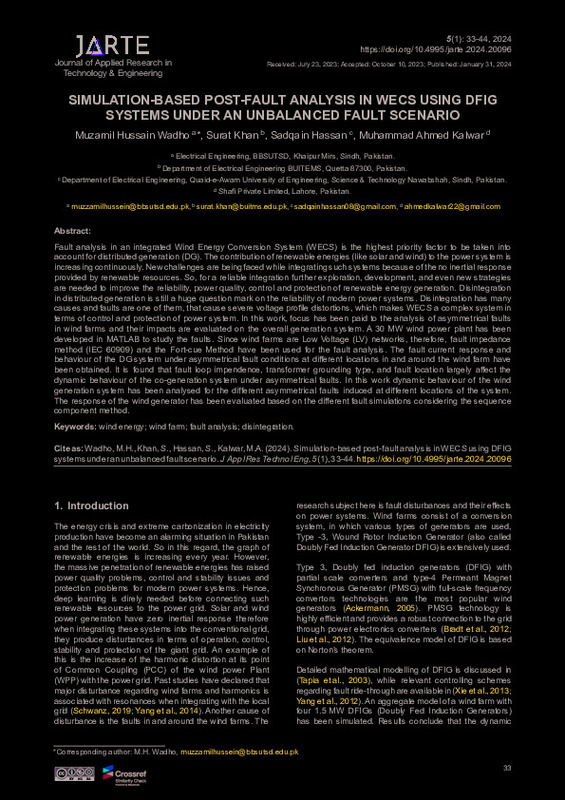JavaScript is disabled for your browser. Some features of this site may not work without it.
Buscar en RiuNet
Listar
Mi cuenta
Estadísticas
Ayuda RiuNet
Admin. UPV
Simulation-based post-fault analysis in WECS using DFIG systems under an unbalanced fault scenario
Mostrar el registro sencillo del ítem
Ficheros en el ítem
| dc.contributor.author | Wadho, Muzamil Hussain
|
es_ES |
| dc.contributor.author | Khan, Surat
|
es_ES |
| dc.contributor.author | Hassan, Sadqain
|
es_ES |
| dc.contributor.author | Kalwar, Muhammad Ahmed
|
es_ES |
| dc.date.accessioned | 2024-01-31T08:01:14Z | |
| dc.date.available | 2024-01-31T08:01:14Z | |
| dc.date.issued | 2023-10-01 | |
| dc.identifier.uri | http://hdl.handle.net/10251/202240 | |
| dc.description.abstract | [EN] Fault analysis in an integrated Wind Energy Conversion System (WECS) is the highest priority factor to be taken into account for distributed generation (DG). The contribution of renewable energies (like solar and wind) to the power system is increasing continuously. New challenges are being faced while integrating such systems because of the no inertial response provided by renewable resources. So, for a reliable integration further exploration, development, and even new strategies are needed to improve the reliability, power quality, control and protection of renewable energy generation. Disintegration in distributed generation is still a huge question mark on the reliability of modern power systems. Disintegration has many causes and faults are one of them, that cause severe voltage profile distortions, which makes WECS a complex system in terms of control and protection of power system. In this work, focus has been paid to the analysis of asymmetrical faults in wind farms and their impacts are evaluated on the overall generation system. A 30 MW wind power plant has been developed in MATLAB to study the faults. Since wind farms are Low Voltage (LV) networks, therefore, fault impedance method (IEC 60909) and the Fort-cue Method have been used for the fault analysis. The fault current response and behaviour of the DG system under asymmetrical fault conditions at different locations in and around the wind farm have been obtained. It is found that fault loop impendence, transformer grounding type, and fault location largely affect the dynamic behaviour of the co-generation system under asymmetrical faults. In this work dynamic behaviour of the wind generation system has been analysed for the different asymmetrical faults induced at different locations of the system. The response of the wind generator has been evaluated based on the different fault simulations considering the sequence component method. | es_ES |
| dc.language | Inglés | es_ES |
| dc.publisher | Universitat Politècnica de València | es_ES |
| dc.relation.ispartof | Journal of Applied Research in Technology & Engineering | es_ES |
| dc.rights | Reconocimiento - No comercial - Compartir igual (by-nc-sa) | es_ES |
| dc.subject | Wind energy | es_ES |
| dc.subject | Wind farm | es_ES |
| dc.subject | Fault analysis | es_ES |
| dc.subject | Disintegration | es_ES |
| dc.title | Simulation-based post-fault analysis in WECS using DFIG systems under an unbalanced fault scenario | es_ES |
| dc.type | Artículo | es_ES |
| dc.identifier.doi | 10.4995/jarte.2024.20096 | |
| dc.rights.accessRights | Abierto | es_ES |
| dc.description.bibliographicCitation | Wadho, MH.; Khan, S.; Hassan, S.; Kalwar, MA. (2023). Simulation-based post-fault analysis in WECS using DFIG systems under an unbalanced fault scenario. Journal of Applied Research in Technology & Engineering. 5(1):33-44. https://doi.org/10.4995/jarte.2024.20096 | es_ES |
| dc.description.accrualMethod | OJS | es_ES |
| dc.relation.publisherversion | https://doi.org/10.4995/jarte.2024.20096 | es_ES |
| dc.description.upvformatpinicio | 33 | es_ES |
| dc.description.upvformatpfin | 44 | es_ES |
| dc.type.version | info:eu-repo/semantics/publishedVersion | es_ES |
| dc.description.volume | 5 | es_ES |
| dc.description.issue | 1 | es_ES |
| dc.identifier.eissn | 2695-8821 | |
| dc.relation.pasarela | OJS\20096 | es_ES |








